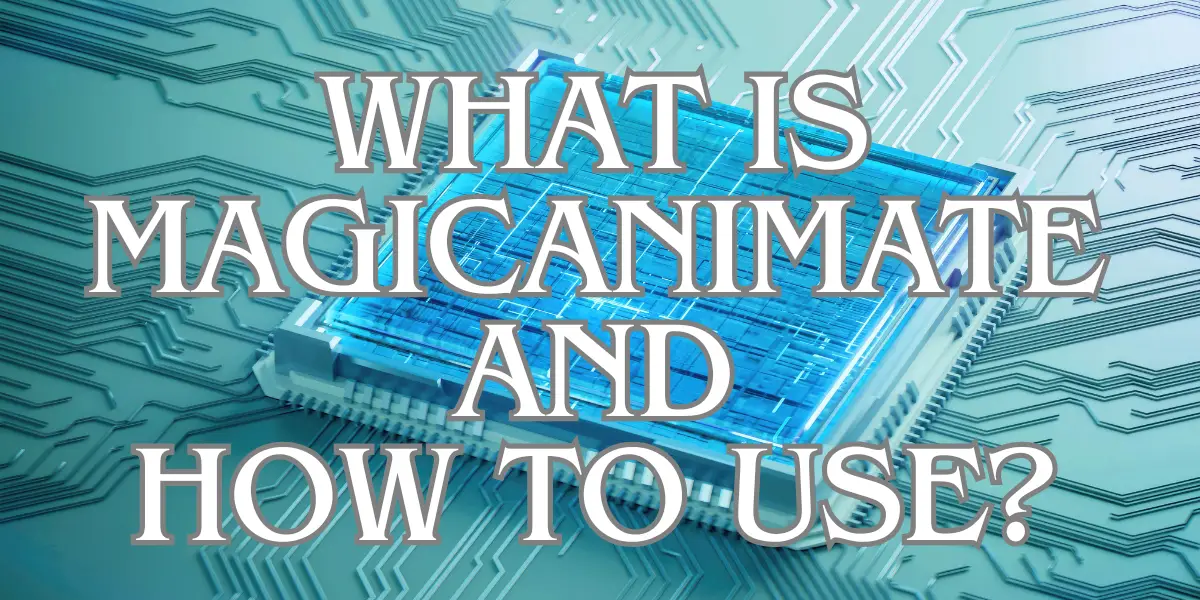What is MagicAnimate And How to Use? A Step-by-Step Guide

Welcome to the fascinating world of AI tools, where innovation meets creativity. In this exploration, we dive into the realm of MagicAnimate, a groundbreaking AI animation tool developed by Show Lab and Bytedance. This remarkable technology has ushered in a new era in digital animation, offering the unique ability to transform static images into lifelike, dynamic animations. MagicAnimate stands as a testament to the incredible advancements in AI, redefining the boundaries of what’s possible in digital art and animation. From filmmakers and game developers to educators and content creators, MagicAnimate opens up a world of possibilities, enabling users to bring their static images to life with unprecedented realism.
MagicAnimate, a groundbreaking AI animation tool, transforms static images into lifelike animations, impacting various industries and presenting both opportunities and challenges.
Table of Contents
What is MagicAnimate?
MagicAnimate is an innovative open-source framework designed for animating static images with realistic human motion. Developed by Show Lab at the National University of Singapore in collaboration with Bytedance, MagicAnimate was introduced to the public in December 2023. This cutting-edge tool leverages diffusion-based techniques and advanced algorithms to bring life to still images, allowing them to move and act in a lifelike manner. By incorporating motion and dynamics from a video source, MagicAnimate can transform a single image into a dynamic, animated sequence. Its unique ability to maintain temporal consistency and preserve the original appearance of the reference image sets it apart in the field of digital animation. MagicAnimate’s introduction marks a significant advancement in AI-driven animation, offering a wide range of applications from entertainment and education to content creation for social media and marketing.
Also read:10 Best AI Video Generators in 2023
Functions of MagicAnimate
MagicAnimate, a cutting-edge AI tool, offers a range of functionalities that are reshaping the landscape of digital animation and image processing.
Realistic Human Animation
MagicAnimate stands out for its ability to animate human images with remarkable realism.
- Brings Static Images to Life: Transforms still photos into dynamic videos, infusing them with lifelike motion.
- Maintains Temporal Consistency: Ensures that the animations are not only visually stunning but also exhibit a natural flow over time, crucial for realistic human animation.
- High-Quality Output: The animations produced are fluid and lifelike, maintaining the high resolution and detail of the input images.
Integration with Other AI Models
One of the most innovative aspects of MagicAnimate is its ability to work in tandem with other AI models, such as DALLE3.
- Expanding Creative Possibilities: Allows for the animation of text-prompted images, broadening the scope of creative expression.
- Enhancing Image Dynamics: By integrating with T2I diffusion models, MagicAnimate can bring more nuanced and dynamic actions to static images.
- Versatile Applications: This feature opens up new avenues for content creation across various media and platforms.
Cross-Domain Animation Capabilities
MagicAnimate’s ability to animate across different domains is a testament to its versatility.
- Transcends Artistic Boundaries: Can animate reference images from various sources, including artworks and movie characters.
- Adapts to Various Styles: Capable of handling animations in different artistic styles, from oil paintings to anime.
- Innovative Content Creation: This function allows for the creation of unique and diverse animated content, appealing to a wide range of audiences.

How to Use MagicAnimate?
Step 1: Accessing MagicAnimate
The first step to using MagicAnimate is accessing the platform. You can visit the official MagicAnimate website or its GitHub page. This initial step is crucial as it is where you’ll find all the necessary resources and information about the tool. The website often provides comprehensive guides, tutorials, and links to download the required software and models. For those who are more technically inclined, the GitHub page offers access to the source code, allowing for a deeper understanding and customization of the tool. It’s important to familiarize yourself with the platform, understand its capabilities, and ensure that your system meets the necessary requirements for running the software.
Step 2: Preparing Your Images and Videos
Once you have access to MagicAnimate, the next step is to prepare the images and videos you want to animate. This involves selecting a static reference image and a motion video that will be used to animate the image. The reference image can be a photograph, a piece of artwork, or any other static image. The motion video will serve as the template for the animation, dictating the movements and actions that will be applied to the static image. It’s important to choose a motion video that closely aligns with the desired outcome of your animation. This step is crucial as the quality and compatibility of your chosen image and video will directly impact the effectiveness of the animation process.
Step 3: Setting Up the Environment
Before you can start animating, you need to set up the MagicAnimate environment on your computer. This involves installing the necessary software and dependencies. According to the information provided on the MagicAnimate website and GitHub, this includes Python (version 3.8 or higher), CUDA (version 11.3 or higher), and ffmpeg. These prerequisites are essential for running the diffusion models and other algorithms used by MagicAnimate. The installation process might vary slightly depending on your operating system, but detailed instructions are typically provided on the platform. Ensuring that your environment is correctly set up is key to a smooth and successful animation experience.
Step 4: Downloading and Installing Models
With your environment ready, the next step is to download and install the pretrained models required by MagicAnimate. These models, such as the StableDiffusion V1.5 and MSE-finetuned VAE, are crucial for the tool to function correctly. They can be found on the MagicAnimate website or GitHub page. Once downloaded, you’ll need to follow the provided instructions to properly install and integrate these models into the MagicAnimate framework. This step is essential as these models form the backbone of the animation process, enabling the tool to effectively animate your static images using the motion video.
Step 5: Animating Your Images
Now that everything is set up, you’re ready to start animating your images. This involves running the MagicAnimate tool, inputting your static image and motion video, and then initiating the animation process. The tool will use the motion video to apply realistic movements to your static image, creating a dynamic animated sequence. During this process, you can adjust various parameters to fine-tune the animation, such as the number of inference steps, guidance scale, and seed for randomization. Once the animation process is complete, you’ll be able to view and save your animated sequence. This final step is where you see your static image come to life, showcasing the power and capabilities of MagicAnimate.

Pros & Cons of MagicAnimate
Advantages of MagicAnimate
MagicAnimate’s strengths lie in its innovative approach to animation and its advanced technological capabilities.
High-Quality Animation: MagicAnimate excels in creating animations that are both high in quality and detail, offering a level of realism that is hard to match.
- Produces smooth and lifelike animations.
- Maintains high resolution and detail throughout the animation process.
- Ensures temporal consistency in animations.
Versatility in Application: The tool’s ability to animate a wide range of images makes it versatile.
- Can animate images across various domains and styles.
- Suitable for both artistic and practical applications.
- Offers creative freedom in animating different types of images.
Integration with Other AI Models: MagicAnimate’s compatibility with other AI models like DALLE3 enhances its functionality.
- Allows for the animation of text-prompted images.
- Expands creative possibilities with dynamic actions.
- Enables users to generate animated visuals based on textual descriptions.
Limitations of MagicAnimate
Despite its strengths, MagicAnimate also faces certain challenges and limitations.
Technical Complexity: The tool requires a certain level of technical expertise to use effectively.
- Installation and setup may be challenging for non-technical users.
- Requires understanding of Python programming and CUDA for optimal use.
- Necessitates downloading and installing specific models and dependencies.
Quality Inconsistencies: While generally high in quality, some animations may exhibit inconsistencies.
- Occasional issues with distortion in facial and hand features.
- Style shifts can occur, especially when transitioning from anime to realism.
- Alterations in body proportions when applying certain styles.
Resource Intensive: The process of animating images can be resource-intensive.
- Requires a powerful computer with specific software and hardware capabilities.
- The animation process can be time-consuming, depending on the complexity of the task.
- May not be suitable for users with limited computational resources.

The Technical Intricacies of MagicAnimate
Diffusion-Based Animation Technique
At the core of MagicAnimate is its diffusion-based animation technique, a key component that sets it apart in the field of AI-driven animation.
- Utilizes Advanced Diffusion Models: MagicAnimate employs diffusion models, which are a subset of generative models in machine learning, known for creating high-quality, detailed images.
- Transforms Pixels into Coherent Images: These models work by gradually transforming a random distribution of pixels into a coherent, detailed image, ensuring realism and high fidelity in the animations.
- Ensures Temporal Consistency: A standout feature of these models is their ability to maintain temporal consistency, making the animations not only visually appealing but also naturally flowing over time.
Data Handling and Preparation
The initial stage of MagicAnimate’s process involves sophisticated data handling and preparation, which is crucial for the success of the animation.
- Processes Input Images with Advanced Techniques: The system begins by analyzing the human figure within the input images, recognizing facial expressions, body postures, and movements.
- Accurate Data Capture for Animation: This step ensures that the initial data is accurately captured, which is essential for the subsequent animation steps to produce realistic and coherent results.
Integration with AI Models
MagicAnimate’s ability to integrate with other AI models, particularly Text-to-Image (T2I) diffusion models like DALLE3, significantly enhances its capabilities.
- Brings Text-Prompted Images to Life: This integration allows for the animation of images based on text prompts, opening up new creative avenues.
- Enables Dynamic Actions in Animations: The combination of text-to-image models with MagicAnimate’s animation technology allows for the creation of dynamic, action-oriented animations.
- Expands Creative Possibilities: This feature broadens the scope of what can be achieved with MagicAnimate, enabling users to explore a wider range of creative ideas.
Final Output and Rendering
The final step in MagicAnimate’s process is the rendering of the animated sequences, a critical phase that determines the quality of the output.
- Maintains High Resolution and Detail: The system ensures that the final output retains the high resolution and detail of the input images.
- Produces Lifelike Animations: The rendered animations are indistinguishable from real-life human motion in terms of quality and realism, making them suitable for various professional applications.

The Use Case of MagicAnimate
Film and Entertainment Industry
MagicAnimate is revolutionizing the film and entertainment industry by providing filmmakers and animators with a powerful tool for creating realistic human animations. Its ability to animate static images with lifelike motion opens up new possibilities for special effects, character creation, and storytelling. For instance, directors can use MagicAnimate to bring historical figures to life in documentaries or create fantastical characters in animated movies. This technology not only enhances the visual appeal of films and animations but also offers a cost-effective solution for producing high-quality content. By reducing the time and resources needed for traditional animation techniques, MagicAnimate enables studios to experiment with more creative ideas and produce content more efficiently.
Gaming and Virtual Reality
In the gaming and virtual reality (VR) sectors, MagicAnimate is making a significant impact. Game developers can use this tool to create more expressive and realistic characters, enhancing the overall gaming experience. In VR, MagicAnimate can be used to animate avatars and other elements, making virtual environments more immersive and interactive. This technology is particularly beneficial for indie game developers and small VR studios, as it allows them to develop high-quality content without the need for large animation teams. The realistic animations produced by MagicAnimate also have the potential to blur the lines between the virtual and real worlds, pushing the boundaries of what’s possible in gaming and VR experiences.
Educational Applications
MagicAnimate’s potential in educational settings is vast. Educators can use it to create animated visuals that make learning more engaging and interactive. For example, in history classes, teachers can animate historical figures or events, providing students with a visual representation that enhances understanding and retention. In art education, MagicAnimate can be used to demonstrate different art styles or techniques. The tool’s ability to bring static images to life can also aid in creative writing and storytelling exercises, encouraging students to explore their creativity. By making learning materials more dynamic and visually appealing, MagicAnimate can play a crucial role in modernizing educational methods and improving student engagement.
The Impacts of MagicAnimate
Influence on Digital Art
MagicAnimate significantly impacts the digital art world. By providing artists and designers with a tool that can animate static images with lifelike motion, it opens up new avenues for creative expression. Artists can now transform their artworks into dynamic pieces, adding a new dimension to their creations. This capability not only enhances the visual appeal of digital art but also expands the storytelling potential, allowing artists to convey their messages more dynamically and engagingly. Furthermore, MagicAnimate democratizes the animation process, making it accessible to artists who may not have traditional animation skills, thereby fostering a more inclusive digital art community.
Impact on Content Consumption
The way audiences consume content is also evolving due to MagicAnimate. In the era of short attention spans, animated content stands out more in the crowded digital space. MagicAnimate enables content creators, including marketers and social media influencers, to produce eye-catching animations that are more likely to engage viewers. This shift towards more animated content could lead to changes in audience preferences, with a growing expectation for dynamic and interactive media. Consequently, this tool could drive a broader trend in the digital content landscape, where animation becomes a standard element in various forms of media, from advertising to educational materials.
Ethical Considerations
The introduction of MagicAnimate also brings ethical considerations to the forefront. The ability to animate any image with realistic human motion raises questions about consent and representation, especially when animating images of real people. There’s a potential risk of misuse, where animations could be created without the subject’s consent, leading to privacy violations or misrepresentation. Additionally, the realism of these animations blurs the line between reality and AI-generated content, potentially leading to challenges in distinguishing between the two. As such, MagicAnimate’s impact extends beyond technology and art, prompting a necessary discourse on the ethical use of AI in digital media creation.
The Future of MagicAnimate
Technological Evolution and Integration
The future of MagicAnimate is poised for significant technological evolution, enhancing its capabilities and user experience. We can anticipate advancements in the tool’s core algorithms, leading to even more realistic and detailed animations. These improvements will likely focus on refining the nuances of human motion and expression, making the animations indistinguishable from real-life movements. Additionally, integration with emerging AI technologies, such as more advanced natural language processing and machine learning models, could enable MagicAnimate to understand and interpret complex animation requests better. This integration will not only streamline the animation process but also expand the creative possibilities, allowing users to bring even the most intricate visions to life. As MagicAnimate evolves, it will continue to push the boundaries of what’s possible in digital animation, making it an increasingly indispensable tool for professionals and hobbyists alike.
Widening Scope of Applications
Looking ahead, MagicAnimate is set to expand its influence across various sectors. In the entertainment industry, it could revolutionize animation and special effects, offering filmmakers and game developers a powerful tool to create immersive experiences. In education, MagicAnimate has the potential to transform teaching methodologies by providing interactive and engaging visual aids, making learning more effective and enjoyable. The tool could also see increased use in marketing and advertising, where dynamic and eye-catching animations can significantly enhance brand messaging and audience engagement. Furthermore, as virtual and augmented reality technologies continue to advance, MagicAnimate could play a crucial role in creating lifelike avatars and environments, further blurring the lines between the virtual and real worlds. This expansion in applications will not only showcase MagicAnimate’s versatility but also cement its position as a leading tool in the realm of AI-driven animation.
MagicAnimate vs Animate Anyone
MagicAnimate: Advanced Diffusion-Based Framework
MagicAnimate, developed by Show Lab, National University of Singapore, and Bytedance, stands out for its diffusion-based framework. This technology is particularly adept at maintaining temporal consistency, crucial for creating animations that flow naturally over time. MagicAnimate’s key strengths include:
- Versatile Animation Capabilities: It can animate images from various sources, including cross-ID animations and unseen domains like oil paintings and movie characters.
- Integration with T2I Models: MagicAnimate seamlessly integrates with Text-to-Image diffusion models like DALLE3, enhancing its ability to bring text-prompted images to life with dynamic actions.
- High Fidelity and Consistency: The tool is known for its high consistency in animation, particularly in dance video solutions, while maintaining the original style and appearance of the reference images.
Animate Anyone: User-Friendly and Customizable
Animate Anyone, developed by Alibaba, focuses on user-friendliness and customization in animating still images. Its features include:
- Realistic Animation Synthesis: Animate Anyone excels in creating realistic animations, synthesizing motion from a variety of sources to animate still images.
- High Customizability: Users have significant control over the animation process, allowing for personalized and unique outputs.
- Speed and Efficiency: The tool is designed for quick rendering and exporting, making it efficient for both professional and personal use.
Also read:Alibaba’s Animate Anyone AI: Turning Still Images into Dynamic Art
Conclusion
In summary, MagicAnimate represents a significant breakthrough in the realm of AI-driven animation. Developed by Show Lab and Bytedance, this innovative tool has revolutionized the way we approach animation, offering a seamless blend of realism and creativity. Its ability to animate static images with lifelike motion has vast applications across various industries, including film, gaming, education, and digital content creation. While it brings numerous advantages like high-quality animation, versatility, and integration with other AI models, it also faces challenges such as technical complexity and potential ethical concerns. As MagicAnimate continues to evolve, its future promises even more advanced capabilities and broader applications, solidifying its position as a pivotal tool in digital creativity and AI technology.

